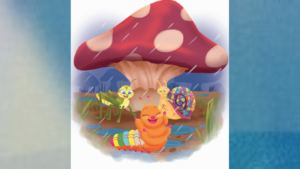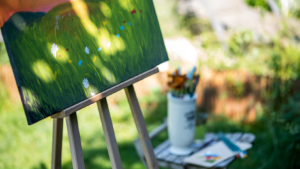My Dad Was Always Prepared
My Dad Was Always Prepared
Mom would give Dad a clean crisp package of handkerchiefs for every Thanksgiving and Christmas. He would take a close look at them, smile, and thank her—then, *shoop* into Dad’s pants pocket, one of the handkerchiefs would go. I will never forget my dad’s pants. More specifically, his pockets. It didn’t matter if he wore jeans, work pants, overhauls, or a suit … he always had three bulging pockets.
In his front right, there was always a stubby screwdriver, a pocketknife with at least five blades, a coin pouch (the type that you squeeze on the sides and opens like a duck’s bill), and usually some binding material (twine, twist ties, baling wire, a small roll of duct tape, etc.).
The front left was reserved for the “quick reference area.” Receipts, checks (usually kept in a little plastic bag), a little business card-sized notepad, and a stubby pencil. If he were out on the ranch/farm, he would usually have his pliers in a holster on his right hip—think Quick Draw McGraw, only with pliers instead of a Colt revolver. But if he were “dressing,” he’d slip the pliers in the front left pocket with his “paperwork.”
The rear right always had a two-inch thick billfold that was brimming over with pictures, cards, more checks, phone numbers, addresses, leads of upcoming livestock sales, advertisements, Christmas present ideas for friends and family … oh yeah, and a few dollar bills.

The rear left? Well, that was sacred ground. Dad always carried two handkerchiefs. He used to say, “One for me and one for somebody who needs it.” I’ve lost track of the times when I saw Dad just hand over a handkerchief to someone in tears at a funeral, wedding, or just because. He’d give it to a mother or father who was trying to take care of their child who had a runny nose or skinned knee.
Dad was sort of like the parable of the Ten Virgins. “Behold, the bridegroom! Come out to meet him! Then all those virgins got up and trimmed their lamps …” His lamp was always trimmed, at the ready, and he always carried just enough oil.
And Dad had the wisdom of Wisdom 6, “For taking thought of wisdom is the perfection of prudence, and whoever for her sake keeps vigil shall quickly be free from care…” He was always ready, looking, vigilant for things to be fixed earlier rather than later so they didn’t deteriorate or become worse. He didn’t have a care; he knew he was ready!
Fast Forward
In retirement, Dad retained his chipmunk pockets, even after being diagnosed with Parkinson’s and waking one morning in long-term care. On the first day, the admissions nurse went through all his personal belongings. They wouldn’t let him keep the majority of things he always carried in his overflowing pockets.
With head down, a slight smile on his face, he handed over all his lifetime pocket loot to me and said, “Well, this is yours now.” I looked through the plastic shopping bag and asked if he wanted to keep the small notepad and stubby pencil. He just glanced up and said, “Nah, you still need it. I’m retired. You take over,” and he wheeled down the hallway. It was like the gates had opened and then closed behind him. He didn’t have to be vigilant; he didn’t have to stay awake any longer. It was time for the banquet—and he was inside the gates.
Now, I always carry a handkerchief that my wife has embroidered a special note or character on. Thanks, Dad.
Copyright 2023 Ben Bongers

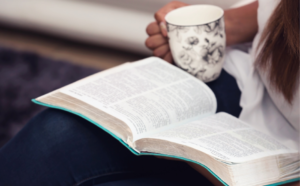 I cannot recall the topic we were discussing when my director began to share a story about a three-handled coffee mug. She told me when she presented this thought exercise to others in the past, they became overwhelmed and anxious at the thought of how to hold it or use it. As I began to imagine it in my mind, I was intrigued and excited all at the same time. When my spiritual director asked how the three handled mug made me feel, I couldn’t help but share that I saw the persons of the Trinity—a handle for Father, Son, and Holy Spirit.
I cannot recall the topic we were discussing when my director began to share a story about a three-handled coffee mug. She told me when she presented this thought exercise to others in the past, they became overwhelmed and anxious at the thought of how to hold it or use it. As I began to imagine it in my mind, I was intrigued and excited all at the same time. When my spiritual director asked how the three handled mug made me feel, I couldn’t help but share that I saw the persons of the Trinity—a handle for Father, Son, and Holy Spirit.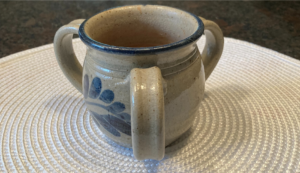 The cup is hand-made pottery, with a bumpy texture. The sentimental type I am, I can imagine the hands of the person who created it. I slide my fingertip across the initials scratched into the bottom, too blurred to make out. A reminder of my imperfections and the faithfulness of God. The space where the handles joined the cup reveals finger swipes, merging the clay. A prayerful moment brings me peace in connecting with another person who loved that cup while combining myself with the persons of the Trinity.
The cup is hand-made pottery, with a bumpy texture. The sentimental type I am, I can imagine the hands of the person who created it. I slide my fingertip across the initials scratched into the bottom, too blurred to make out. A reminder of my imperfections and the faithfulness of God. The space where the handles joined the cup reveals finger swipes, merging the clay. A prayerful moment brings me peace in connecting with another person who loved that cup while combining myself with the persons of the Trinity.
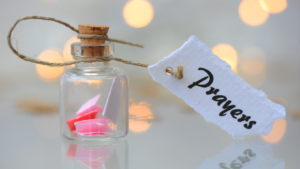
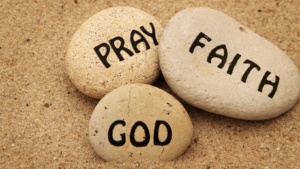
 Let me begin, then, by saying that I never intended to become “the chicken lady” of my neighborhood. When my husband called from work one day, saying that a colleague had no further need of 4 unhatched baby chicks and did I think we could take them in for a while, I said “Sure” simply because I like animals and couldn’t stand the thought of those little chickies being – literally – thrown away. That was about the extent of my thinking.
Let me begin, then, by saying that I never intended to become “the chicken lady” of my neighborhood. When my husband called from work one day, saying that a colleague had no further need of 4 unhatched baby chicks and did I think we could take them in for a while, I said “Sure” simply because I like animals and couldn’t stand the thought of those little chickies being – literally – thrown away. That was about the extent of my thinking. My little flock did not choose each other, but they’ve formed themselves into a community nevertheless. Although they are all different types of hens, they get along. Yes, there is certainly a pecking order (Sandy is at the top) but there is still room for everyone, despite their various temperaments. For example, Pebbles, our black Australorp, tends to get broody and take over the nesting box, while Pepper, a light Brahma and the smallest of the five chickens, likes to make up for her small size by being feisty and pecking everyone, including the dogs. Occasionally there are some ruffled feathers but most of the time there are contented, chatty clucks and check-ins, and at the end of the day they all go into the hen house and sleep peacefully together. If I’ve had a hard day with a difficult person, I really notice their ability to not hold a grudge and to let bygones be bygones. It reminds me that I might not always want to spend a lot of time around a certain person or persons, but I don’t have to take everything personally and I don’t have to carry resentment with me every day. (And I’m always somewhat flabbergasted that the hens consider our two pitties part of their community!)
My little flock did not choose each other, but they’ve formed themselves into a community nevertheless. Although they are all different types of hens, they get along. Yes, there is certainly a pecking order (Sandy is at the top) but there is still room for everyone, despite their various temperaments. For example, Pebbles, our black Australorp, tends to get broody and take over the nesting box, while Pepper, a light Brahma and the smallest of the five chickens, likes to make up for her small size by being feisty and pecking everyone, including the dogs. Occasionally there are some ruffled feathers but most of the time there are contented, chatty clucks and check-ins, and at the end of the day they all go into the hen house and sleep peacefully together. If I’ve had a hard day with a difficult person, I really notice their ability to not hold a grudge and to let bygones be bygones. It reminds me that I might not always want to spend a lot of time around a certain person or persons, but I don’t have to take everything personally and I don’t have to carry resentment with me every day. (And I’m always somewhat flabbergasted that the hens consider our two pitties part of their community!)